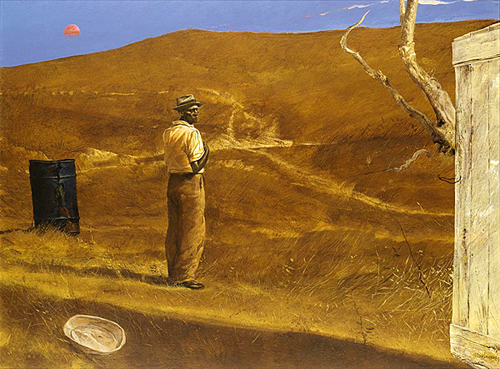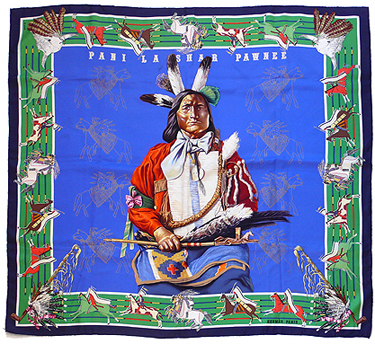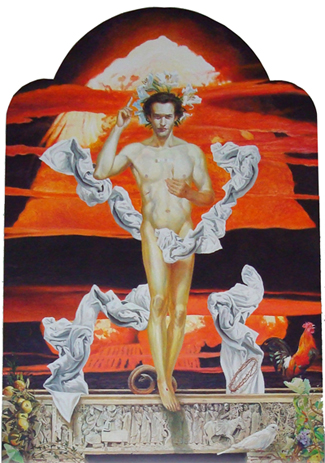The painting showed a lone black man in a pastoral scene emboldened with brilliant tones of caramel colors.
I ventured closer to it, eager to find out who had created such a powerful image. I looked up the bid number in the auction catalog and found that it was signed on the back: Kermit Oliver. I’d never heard of him and wanted to know more, but I breezed through the research in the catalog because I wanted to take in the painting a little bit longer.
An acrylic painting, it showed the solitary man at the foot of a hill, a black steel drum to his left and a tree branch and building to his right. He was looking slightly over his right shoulder. The painting was titled “Dusk” and completed in 1972. It reminded me of artist Andrew Wyeth’s lone figures against a minimalist background.

Oliver was described in articles as a man who shied away from publicity to the point of not even attending events in his honor. In 2016, his painting “Tobias” was featured in the inaugural exhibition at the National Museum of African American History and Culture (NMAAHC) in Washington but he seemed unfazed by the distinction.
“My work is there,” he told a Texas newspaper reporter in 2017. “My presence isn’t needed there. It’s the luck of the draw for me. There are so many artists around the world who are worthy of that opportunity.”
Oliver was born in Refugio, a small town in southeastern Texas, and grew up on a ranch where his father worked as a cowboy. A shy kid, he realized at around age 6 or 7 that he was good at drawing horses, cows and other animals.

“When I was a child, they used to call me ‘Turtle’ because I didn’t talk or socialize with the other children much,” he told an interviewer. “Art was one of the only ways I had of expressing myself.”
After high school, he enrolled at the historically black Texas Southern University in Houston where one of his instructors was the artist John Biggers (several of whose works were also sold at the Swann auction). Biggers told him to “stay true to ‘your own message, your own language.'”
In 1971, Oliver became the first African American artist to be represented by a commercial gallery in Houston, the DuBose Gallery.

More than 10 years later, he began designing scarves for the French fashion house Hermes. He is said to be the first and only American to do so. The first of his designs, in 1982, showed a Pawnee Native American chief, and it sold so well that it was reissued. Next came a scarf of Texas wildlife for the state’s sesquicentennial.
Oliver moved to Waco, TX, in 1984 and got a job as a mail sorter at the U.S. Post Office to support his family. He worked the overnight shift and spent his mornings painting. It was around that time that he stepped into the shadows as an artist.
It is believed that he became even more reclusive after a long battle to have the death sentence of his youngest son Khristian commuted. The son, then 21 years old, was convicted of killing a man during a home burglary in 1998. He was executed by lethal injection in 2009, with his parents as witnesses.

Oliver used Khristian’s face on a partially nude and risen Christ in a 9-foot painting titled “Resurrection” in 2003 after his son’s trial. It is mounted above the altar at Trinity Episcopal Church in Waco.
Oliver’s works are in the collections of the Museum of Fine Arts and Texas Southern University in Houston, and the NMAAH, among others.
The “Dusk” painting sold for $112,500 (with the 25 percent premium) at the Swann auction.

Just an FYI: Dusk, described at the beginning of this article is an acrylic painting, not an oil.
Hi Doug. You’re right. Thank you. I rechecked the Swann auction site & it’s acrylic on masonite board.
In 1970, he was represented by Courtney gallery in Houston, who gave him his first solo exhibition and was the first gallery before Dubose to represent him.
Truly a great American artist!
Brillance flows through his veins…
Yes, his work is amazing. I’m very glad I was able to become acquainted with it (and him). You should write a book about your father’s life.
Thanks for sharing this incredible story! I am now wanting to learn more about him.